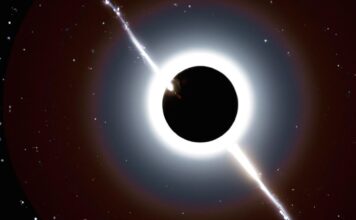“GRB 221009A is the brightest gamma-ray burst event ever detected, with a brightness difference from other events akin to that between a small indoor light and a stadium floodlight. Recently, data from NASA’s Fermi Gamma-ray Space Telescope revealed a previously unseen new feature, resulting from the annihilation of electrons and their antimatter counterparts, positrons, traveling towards us at 99.9% of the speed of light.
Gamma-ray bursts (GRBs) are the most powerful and violent explosions known in the universe. The most common type of GRBs originates from stars with at least eight times the mass of the Sun that have exhausted their core fusion fuel and can no longer counteract their own inward gravitational force.
This process creates a rotating black hole, which channels matter towards its poles and ejects it at nearly the speed of light. When the jet is directed towards Earth, it is observed as a gamma-ray burst.
If a GRB were to occur within a few thousand light-years of Earth, its immense power could potentially destroy Earth’s atmosphere. Among all the terrifying GRB events, GRB 221009A stands out almost instantaneously.
On October 9, 2022, the Fermi Gamma-ray Space Telescope and the Neil Gehrels Swift Observatory detected the brightest gamma-ray burst ever, named “BOAT” (Brightest of All Time), from the direction of the southern constellation Canis Major, approximately 2.2 billion light-years away.
Despite the vast distance, its brightness exceeded any previously observed GRB, and it still disturbed Earth’s lower ionosphere, making it a significant subject of study in the field of astronomy.”
“In fact, GRB 221009A was so intense at its peak that it temporarily blinded all telescopes, only dimming enough to allow normal data collection about five minutes later. During this period, a team from Radboud University in the Netherlands noticed an unusual energy peak recorded by the Fermi telescope.
When light passes through matter, elements absorb and emit light at specific frequencies, leaving absorption and emission ‘fingerprints’ on the light. Scientists can use these fingerprints to reconstruct the elements the light passed through and determine the chemical composition of interacting objects. The researchers observed an unusual emission line feature lasting about 40 seconds, with a peak energy of 12 MeV (12,000,000 eV). For comparison, the energy of visible light typically falls between 2-3 eV.
The researchers suggested that this particular spectral emission line was most likely caused by the annihilation of matter and antimatter: electrons and positrons colliding and annihilating each other. When electrons and positrons collide and annihilate, they usually produce a pair of gamma rays with an energy of 0.511 MeV each, much lower than 12 MeV. To form an emission line peaking at 12 MeV, the annihilating particles must have been moving towards us at about 99.9% of the speed of light, causing a significant blue shift and pushing the energy to higher levels.
Scientists are still meticulously studying the aftermath of the GRB 221009A explosion. For instance, in April this year, another team using the James Webb Space Telescope discovered that GRB 221009A was caused by a supernova explosion but found no evidence of heavy elements forming around it, adding another unresolved mystery about the origin of heavy elements.
The new paper was published in the journal Science.”




